Documents: Go to download!
- Owner's manual - (English, French)
- Getting Started
- Rinse Aid
- Loading the Dishwasher
- Detergent
- Operating the Dishwasher
- Care and Maintenance
- Troubleshooting
Table of contents
Operating instructions Dishwasher
Getting Started
Appliance overview
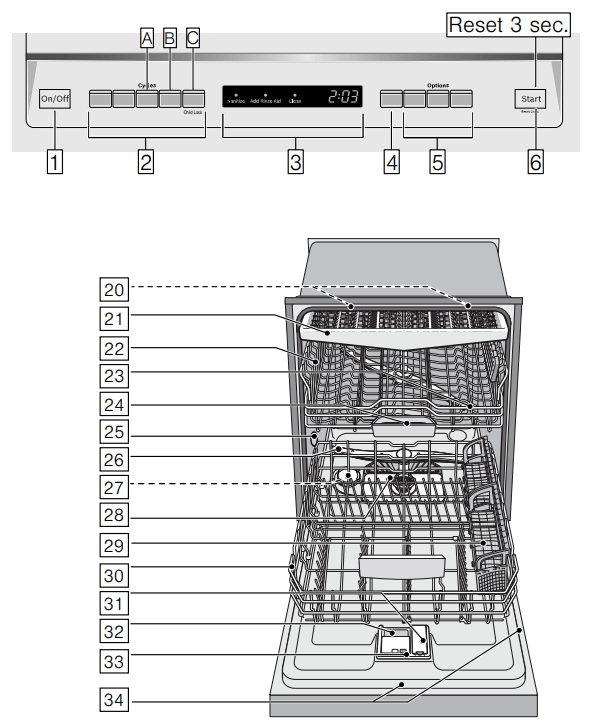
- The dotted lines show optional features which may or may not be included with your dishwasher.
- The numbers stated below refer to the overview images on the previous page of this manual.
Operating panel
1On/Off button
2 Wash cycles
3 Digital display
4 Delay start button
5 Wash cycle options
6 Start button
Dishwasher interior components
20 Interior light *
21 Third rack
22 Upper rack
23 Upper spray arm
24 Detergent tab tray
25 Vent hole
26 Lower spray arm
27 Dispenser for special salt*
28 Filters
29 Silverware basket
30 Lower rack
31 Rinse aid dispenser
32 Detergent dispenser
33 Lock for detergent dispenser
34 Rating plate
* optional feature which may or may not be included with your dishwasher.
Display indicators
 |
Cycle time remaining |
| Clean | Lights up when dishes are clean |
| Sanitize | Lights up when sanitation requirements are met |
| Add Rinse Aid | Lights up when rinse aid is low |
Menu overview
- The dishwasher has been preset with certain settings for your convenience. You can change these factory settings.
- Use the function keys A, B and C to change the settings.
| Setting | Factory setting | Description |
|
|
 |
Amount of rinse aid affects drying. When using Multitabs, select setting 0 |
|
|
 / Off / Off |
Improved drying for glasses and plasticware. |
|
|
 |
Dishwasher switches off automatically after wash cycle is complete. |
 Rinse Aid
Rinse Aid
- To achieve proper drying, always use a liquid rinse aid, even if your detergent contains a rinse aid or drying additive.
- Note: The dishwasher indicates low rinse aid by turning on the Rinse Aid indicator on the display 3. If this indicator lights up, you need to refill the rinse aid dispenser 31 by following the directions below.
Adding rinse aid
1. Open the rinse aid dispenser 31 by pressing on the latch of the lid and pull it open.

2. Add liquid rinse aid to the dispenser 31 until it is full. Do not overfill.

3. Close the lid. Lid must be fully closed until it clicks in order to seal.
4. Wipe up any excess rinse aid that may have puddled when the dispenser reservoir is full.
The indicator light will go out a few moments after the dishwasher door is shut.
Setting the amount of rinse aid used
- The amount of rinse aid dispensed can be set from
 to
to  . The factory setting is
. The factory setting is  .
. - You should only change the setting if streaks remain on the dishes (lower the amount), or if dishes are not getting dry enough (increase the amount).
| Setting | Amount |
|
|
dispenser is OFF |
 |
lowest setting |
 |
low setting |
 |
medium setting |
 |
medium/high setting |
|
|
high setting |
|
|
highest setting |
- Press the On/Off button 1.
- Hold down the function key A and press the Start button 6 until the display 3 indicates
 (x can be any number). Release both buttons.
(x can be any number). Release both buttons. - Press the function key A until the display 3 shows
 .
. - Press the function key C to select the desired setting.
- Press the Start button 6 to save the setting.
Turning off rinse aid indicator
- Proceed as described in the section “Setting the amount of rinse aid used” and set value to
 . The rinse aid indicator is now turned off.
. The rinse aid indicator is now turned off. - NOTICE: Using no rinse aid or setting the dispenser to
 may result in longer cycle times consuming more energy and water. The higher temperatures and longer cycle times can damage fine china or glassware.
may result in longer cycle times consuming more energy and water. The higher temperatures and longer cycle times can damage fine china or glassware.
 Loading the Dishwasher
Loading the Dishwasher
Dishware material
Recommended
| Aluminum | Colored anodized aluminum may fade over time. Minerals in your water may cause the aluminum to darken or spot. This can usually be removed with a soap-filled steel wool pad. |
| China, Crystal, Stoneware | Some hand-painted utensils may discolor, fade or spot. Hand wash these utensils. Position fragile glassware so that it will not topple over or come in contact with other utensils during the wash cycle. |
| Glass | Milk glass may discolor or become yellow. |
| Non-stick Coatings | Apply a light coating of vegetable oil to non-stick surfaces after drying. |
| Plastics | Make sure the plasticware is dishwasher-safe. |
| Stainless Steel, Sterling Silver and Silver Plates | Load these so they do not come in contact with other metals, stainless steel dishwasher tub walls or the inner door |
Not Recommended
| Acrylic | Crazing or small cracks throughout the acrylic, may occur. |
| AdhesiveJoined Pieces | Adhesives that join materials such as plastic, wood, bone, steel, copper, tin, etc. may loosen. |
| Bone-Handled Utensils | Handles may separate. |
| Iron | Iron will rust. Hand wash and dry immediately. |
| Non-Dishware Items | Your dishwasher is intended for use in cleaning ONLY standard household dishware and kitchenware |
| Pewter, Brass, Bronze | These items will tarnish. Hand wash and dry immediately. |
| Tin | Tin will stain. Hand wash and dry immediately. |
| Wood | Wooden bowls, wooden utensils and utensils with wooden handles can crack, warp and lose their finish |
Loading the racks
For best dishwashing results, observe the following when loading the dishwasher:
- Do not pre-wash items with loosely attached food soil.
- Remove all food particles, bones, toothpicks and excessive grease.
- Pre-treat items having burned-on, baked-on or starchy soils.
- Load dishes in the dishwasher racks so the insides of bowls, pots and pans are facing the spray arms.
- Avoid nesting and contact points between dishes.
- Separate items of dissimilar metals. Use care to not block movement of the spray arms.
- Only wash household dishware and kitchenware rated as dishwasher-safe. Refer to the Dishware Materials section for more information about dishware suitability.
Loading the upper rack
- Ensure items do not protrude through the bottom of the racks and block the spray arms.
- Note: When pushing the upper rack 22 into the dishwasher, push it until it stops against the back of the tub so the upper rack spray arm 23 connects to the water supply at the back of the tub. Do not push racks in using the door.
Loading the lower rack
- Place large items in the lower rack 31 pots, pans and bowls upside down. Do not block the vent hole 25 with tall baking sheets. Load these items on the right side of the dishwasher.
Recommended loading pattern
For daily, regular or typical use
12 place setting
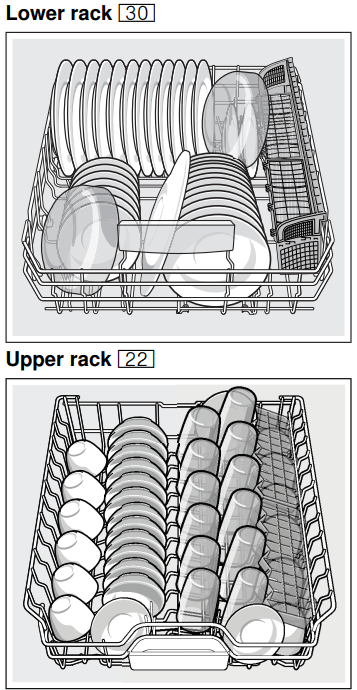
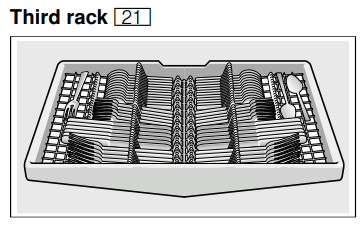
Additional loading pattern
10 place setting
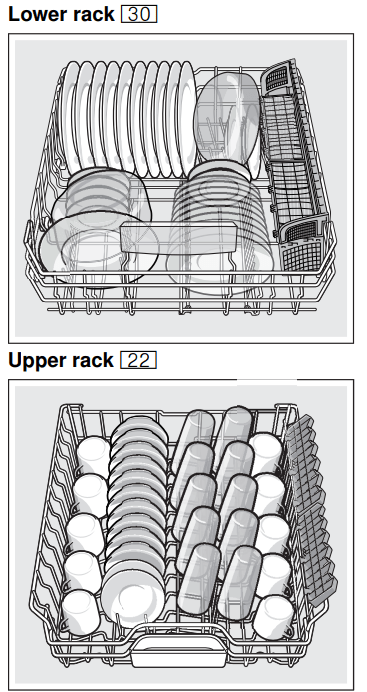

Loading the silverware basket
- Place knives and sharp utensils with their handles up and forks and spoons with their handles down. If large or oddly-shaped items are loaded in the silverware basket, be sure they do not nest together.
Long silverware basket
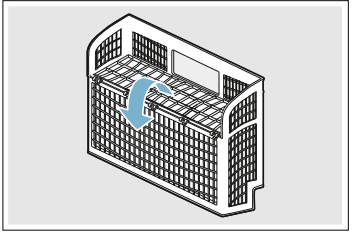
- Note: The silverware basket lid may also be folded downward in order to leave the basket open.
- This dishwasher is equipped with a silverware drawer that should accommodate most silverware loading needs.
- However, if you are washing while the silverware drawer has been removed, or with excess silverware, a silverware basket is also included.
- When loading the silverware basket you should avoid excessive contact points and nesting of similar items (allowing two spons to rest inside one another).
- A good way to avoid excessive contact points is to load the silverware basket with the lids closed, inserting each piece of silverware into one of the individual slots as shown.
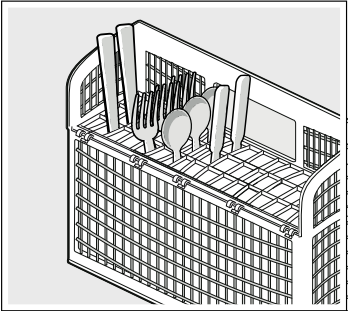
Unloading the dishwasher
- When unloading the dishwasher, to prevent water from dripping onto dry dishes, unload the lower rack 30 first. Next, unload the silverware basket 29 followed by the upper rack 22, and then the third rack (if equipped).
- Note: Dishes are more likely to chip when unloading before cooling.
Removing/Installing third rack

Removing third rack 21
- Pull out third rack all the way (1).
- Lift upper rollers over the stopper hooks of both rails (2).
- Pull third rack out forward and upward so the the holding hooks and the lower rollers of the rack slide over the stopper hooks of both rails (3).

Installing third rack 21
- Pull out third rack rails all the way (1).
- Insert third rack at an angle. Make sure that the stopper hooks of both rails slide in between the holding hooks and the lower rollers of the third rack (2).
- Slide third rack in and lift the upper rollers over the front stopper hooks of both rails (3).
- Push in third rack (4).
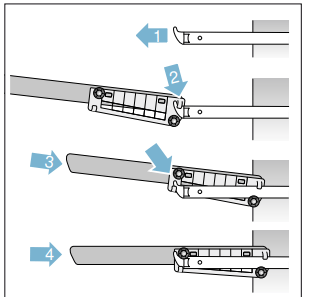
Removing/Installing upper rack with Rackmatic®

Removing upper rack 22
- Pull out upper rack all the way (1).
- Lift front rollers over the stopper hook of the rail (2).
- Pull out upper rack forwards and upwards so that the upper and lower rollers of the rack slide over the stopper hooks of both rails (3)
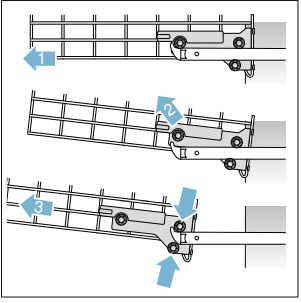
Installing upper rack 22
- Pull out upper rack rails all the way (1).
- Insert upper rack at an angle. Make sure that the stopper hooks of both rails slide in between the upper and lower rollers on the rear side of the rack (2).
- Slide upper rack in and lift the upper rollers over the front stopper hooks of both rails (3).
- Push in upper rack (4).
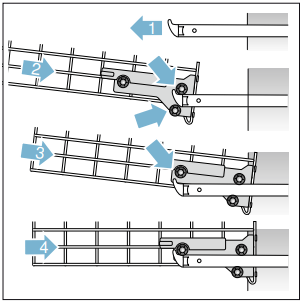
 Detergent
Detergent
- Use only detergent specifically designed for dishwashers. For best results, use fresh powdered dishwashing detergent or detergent tabs.
- NOTICE: To avoid dishwasher damage:
- Do not use hand dishwashing products in your dishwasher.
- Do not use too much detergent if your water is soft. Using too much detergent with soft water may cause etching in glassware and fine china.
- This dishwasher uses less water than most, therefore, less detergent is required. With soft water, 1 tablespoon (15 ml) of detergent will clean most loads. The detergent dispenser cup has lines that measure detergent to 1 tablespoon (15 ml) and 1.75 tablespoons (25 ml). 3 tablespoons (45 ml) of detergent will completely fill the detergent dispenser.
- Note: If you do not know the hardness of your water supply, use 15 ml of detergent. Increase the amount if necessary to the least amount required to get your kitchenware clean.
- Use the measuring lines in the detergent dispenser cup as a guide to measure the amount of detergent recommended in the following table.
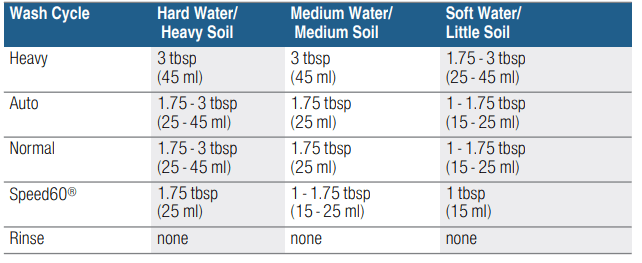
Adding detergent
1. If the detergent dispenser 32 is still closed, actuate the locking bar 33 to open it.
Note: Make sure the detergent dispenser is dry and clear of detergent residue.
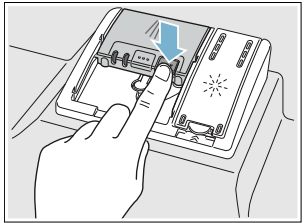
2. Pour detergent into the dry detergent dispenser 32 only. Add detergent. Do not overfill the detergent dispenser.
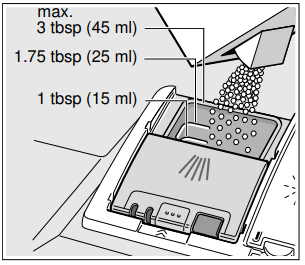
When using detergent tabs, lay them such that they do not come in contact with the cover, insert a detergent tab flat, not on its side.
Note: Do not place detergent tabs or utensils in the detergent tab tray 24. Place tabs or other detergent forms directly in the detergent dispenser 32.

Dosage: see manufacturer’s instructions on the packaging.
3. Close the lid by placing the finger on the lid as shown. Slide the lid closed and press down firmly until it clicks.
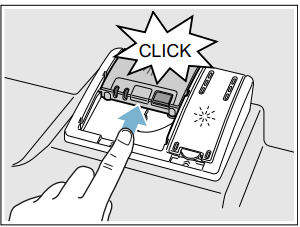
The detergent dispenser will open automatically at the ideal time for the set cycle. The powder or liquid detergent is distributed in the appliance and is dissolved, detergent tabs will fall into the detergent tab tray 24 where it dissolves during the cycle.
Tip: If the dishware is only lightly soiled, slightly less than the indicated amount of detergent is usually adequate.
 Operating the Dishwasher
Operating the Dishwasher
Protection against unintentional operation
Your dishwasher is equipped with a function that helps to prevent unintentional operation (e.g. by children).
After setting the dishwasher, the dishwasher door has to be closed within 4 seconds, otherwise the operation will be paused. There will be a signal on the control panel advising you to press the Start button again and close the door.
This function will be activated when:
- pressing Start to begin a wash cycle
- setting Delay time and pressing Start
- opening the door while Delay time is active
- opening the door during a wash cycle.
Note: This function cannot be deactivated
Operating the touch buttons
- Buttons are sensitive and should be touched gently. Avoid any grease or food particles resting on the buttons as they could activate the dishwasher.
- Wiping and cleaning can also activate the dishwasher. For best results, use bare, clean hands when touching the buttons.
- To clean the touch buttons wipe them with a dry or slightly damp cloth.
AquaSensor
- The AquaSensor is an optical measuring device which measures the cleanliness of the rinse water.
- The AquaSensor is used according to the wash cycle. If the AquaSensor is active, “clean” rinse water can be transferred to the next rinse and water consumption can be reduced by 0.8–1-5 gal (3–6 liters). If the rinse water is not yet clear, the water is drained and is replaced with fresh water. In the automatic wash cycles the temperature and running time can also be adjusted to the degree of soiling.
Switching the appliance on
- Turn the water supply on fully.
- Press the On/Off button 1. The AUTO wash cycle has been preset as a default whenever the appliance starts. This wash cycle remains selected if no other wash cycle button 2 is pressed. Select any desired option.
- Press Start button 6. Wash cycle sequence starts.
Note: Your dishwasher is protected against unintentional operation. If the appliance door remains open for more than 4 seconds after pressing the Start button, the operation will be paused. Close the appliance door and press the Start button P again.
Time display
- When a wash cycle is selected the remaining wash cycle time is shown on the display 3.
- The wash cycle time is determined during the wash cycle by the water temperature, the amount of dishes, as well as the degree of soiling and may vary (depending on the selected wash cycle).
Delay start
You can delay the start of the cycle in one hour increments up to 24 hours.

To set Delay start:
- Press On/Off button 1. Select a cycle.
- Press Delay button 4 until the displayed time corresponds with your requirements.
- Press Start button 6 to activate Delay start.
To cancel Delay start:
- Press Delay button 4 until :
 is indicated on the digital display 3
is indicated on the digital display 3 - Press Start button 6 to save setting.
Note: Your dishwasher is protected against unintentional operation. If the appliance door remains open for more than 4 seconds after pressing the Start button, the operation will be paused. Close the appliance door and press the Start button 6 again.
Wash cycle end
The wash cycle has ended when the display 3 reads 
Auto power off
This setting determines the length of time the control panel stays illuminated after the cycle is complete. To save energy the recommended setting is  .
.
This setting can be adjusted from  to
to  .
.

To change the setting:
- Press the On/Off button 1.
- Hold down the function key A and press the Start button 6 until the display 3 indicates
 (x can be any number).
(x can be any number). - Release both buttons.
- Press the function key A until the display 3 indicates

- Press the function key C until the display corresponds with your requirements.
- Press the Start button 6.
Care and Maintenance
A regular inspection and maintenance of your machine will help to prevent faults. This saves time and prevents future problems.
Overall condition of the dishwasher
NOTICE
- Never use a steam cleaner to clean your dishwasher. The manufacturer is not liable for any resulting damage.
- Regularly wipe the front of the appliance with a damp cloth - water and a small amount of liquid soap is adequate. Do not use sponges as they could scratch the surfaces.
- Do not use bleach-based wipes as they could damage the surface or printing.
- Stainless steel appliances: To prevent corrosion, do not use sponges or chlorine based cleaners. Use a stainless steel polish to seal and protect the surface. Do not use chlorine based cleaners or wipes.
- Clean the outer edges of the inside door panel regularly to remove debris that may collect from normal loading. If spots begin to appear on the stainless steel, make sure the rinse agent is full and functioning properly.
- Clean the door seal regularly with a damp cloth to remove food particles that may collect from normal loading and cause odor. A soiled door seal may not seal properly
WARNING Use caution when removing parts for cleaning as some debris may be sharp.
Filters
The Bosch® filter system 1b is designed to prevent the need to pre-rinse normally attached food soils from your dishes. Simply scrape leftover food soils off of dishware before loading. This process will conserve time, water and the energy require to heat your household water supply.
Your dishwasher filter system is designed to filter 100% of the water entering the spray arms to provide a continuous supply of clean water to remove food soils from your dishware.
Filter components The filter system 28 consists of three parts.
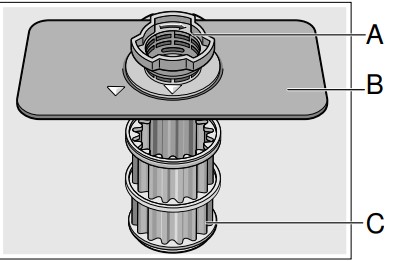
- A Large Object Trap Prevents objects that should not be placed in your dishwasher from damaging the dishwasher pump system or clogging your household drain
- B Flat Fine Filter Prevents food particles from entering the wash chamber and directs particles toward the micro filter.
- C Micro Filter Directs the smallest of particles to the household plumbing drain.
Cleaning intervals
The filter system 28 is designed to minimize maintenance while providing premium cleaning performance and minimum energy consumption.
Depending on use habits and water hardness, the filter system will require some maintenance to sustain premium cleaning performance.
Your filter system may need to be cleaned when:
- You notice food soils remaining on the filter system or objects trapped in the Large Object Trap.
- A drop in cleaning performance or a gritty film forms on the dishware.
When washing normally attached food soils that have been scraped before loading, in a household that runs the dishwasher every other day, your filter should be cleaned:
| Cleaning interval | Use this setting, |
| 3-6 times a year | if you rinse before loading |
| 4-12 times a year | if you only scrape before loading |
| 12 times a year | if you have hard water |
Note: Clean the filter after washing loads with large amounts of food soils or loads with a heavy starch content, like potatoes and pasta, to maintain optimal performance.
To check or clean the filter system:
1. Unscrew the Large Object Trap as illustrated and remove the entire filter system.
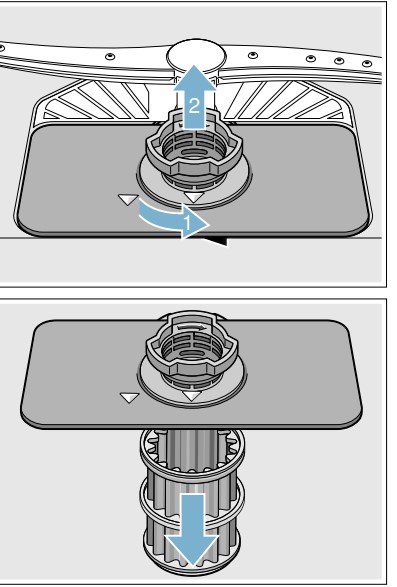
2. Remove any residue and clean filters by rinsing under running water. Note: do not use abrasive brushes or steel wool, etc., as they may damage the filter.
3. Reinstall the filter system in reverse sequence and lock into place by screwing the Large Object Trap until the marking arrows align.
Spray arms
Check spray arms 23, 26 for grease and limescale deposits. If you find such deposits:
- Fill detergent dispenser 32 with detergent and start the appliance without utensils in the cycle with the highest rinsing temperature. ~ "Wash Cycle Information" on page 24
- Clean the appliance with detergents/appliance cleaners which are particularly suitable for use with dishwashers.
- Unscrew the upper spray arm 23 and pull off the lower spray 26 arm as shown. Inspect for deposits.

Drain pump
Large food remnants in the rinsing water not retained by the filters may block the waste water pump. In this case:
- Disconnect the appliance from the power supply.
- Remove the filters. ~ "Filters" on page 30
- Scoop out standing water - use a sponge if necessary.
- Using a spoon, pry off the pump cover until it clicks, then grip the cover and pull upward until it resists and then pull forward.
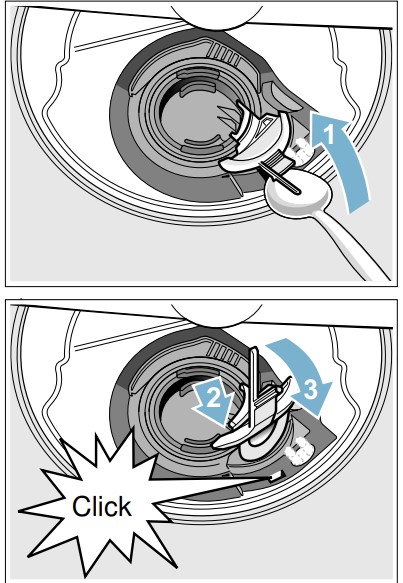
- Check inner compartment and remove any foreign objects.
WARNING Use caution when removing parts for cleaning as some debris may be sharp.
- Place cover in the original position, press down and engage.
- Reinstall filters.
Note: The drain pump will not work properly if the drain pump cover is not snapped in completely until it clicks.
Preparing your unit for vacation
- NOTICE Before leaving for vacation during warmer weather, besides turning off the main valve, also turn off water supply at the nearest point to the dishwasher. Do not leave soiled dishware in unit and leave door slightly open. During colder weather, please follow the instructions for winterizing your unit below.
Winterizing your unit
- NOTICE If your dishwasher will be unused for a period of time in a location that experiences freezing temperatures (holiday home or through a vacation period), have your dishwasher winterized by a professional service.
Troubleshooting
Dishwashers may occasionally exhibit problems that are unrelated to a malfunction of the dishwasher itself.
The following information may help you with a dishwasher problem without involving a repair professional
| Problem | Cause | Action |
| Dishwasher does not start |
Door may not be properly latched. Dishwasher may not be turned on. Dishwasher not reset or previous cycle not completed Delay start engaged. Interruption of electrical power supply to dishwasher or blown fuse The door may have been closed without first selecting a cycle Water supply may not be turned on. |
Shut the door completely until you hear a click Press the main power switch 1 to turn dishwasher on. Reset the dishwasher. Reset Delay start. Check circuit breaker. Select a cycle and close the door Check and turn on water supply |
| Cycle does not resume after door is opened and closed during cycle | Door is opened longer than 4 seconds after a cycle has started | Press Start button again to resume cycle. |
| Display does not illuminate |
A fuse may have been blown or circuit breaker tripped Door not closed or latched. Note: For models with controls on top of the door, the display only illuminates when the door is opened and controls are visible. |
Check the fuse or circuit breaker box and replace the fuse or reset the breaker if necessary. Ensure door is properly latched and completely closed. |
| Dishwasher seems to run a long time |
Incoming water is not warm enough. Cycle time can vary due to soil and water conditions. Rinse aid dispenser 31 is empty, or rinse aid setting has been set to “0”. Dishwasher connected to cold water supply. Note: Check the typical wash cycle length. ~ "Wash Cycle Information" |
Before starting a cycle, run hot water faucet at the sink closest to the dishwasher. Sensors in the dishwasher automatically increase the cycle time to ensure a good wash when heavy soil is detected. Add rinse aid, or change rinse aid setting. Verify dishwasher is connected to hot water supply plumbing. |
| Dishes are not getting clean enough |
Spray arm movement obstructed. Spray arm nozzles clogged. Improper use of detergents. Filters 28 could be clogged. Dishes are nested or loaded too closely together Selected wash cycle is not suitable for food soil conditions |
Ensure that spray arm movement is not blocked by hand rotating spray arms 23, 26 before starting cycle.
Remove spray arms 23, 26 and clean them. ~ "Spray arms" Clean the filters 28. ~ "Filter components" Rearrange load such that water spray can reach all items in the dishwasher. ~ "Loading the Dishwasher" Refer to Wash Cycle Information. ~ "Wash Cycle Information" |
| Streaks on glassware or residue on the dishes | Incorrect rinse aid setting | Depending on the hardness of water, adjust the rinse agent dispenser 31. ~ "Rinse Aid" |
| Dishes are not getting dry enough Note: Plastic or Teflon do not typically dry as well as other items due to their inherent properties. |
Rinse aid dispenser 31 is empty or incorrect rinse aid amount is set. Improper loading of dishes. |
Add rinse aid or adjust setting - the use of rinse agent improves drying, use the Auto cycle, use the Sanitize option. Rearrange load to ensure items are not nesting. ~ "Loading the Dishwasher" on page 13 Note: Select models offer an extra heating option to improve drying performance. |
| Odor Note: Water testing is done in the factory. Occasionally water may still appear in dishwasher at purchase which may create an odor. |
Food debris is present at the bottom of the dishwasher Food particles are present near the door seal Residual water is present at the bottom of the dishwasher. Drain hose is obstructed. |
Remove the filters and clean them. ~ "Care and Maintenance" "Care and Maintenance" Ensure the dishwasher has completely drained from the last cycle. Remove any obstructions from the drain hose by calling qualified personnel. Note: If odor still persists, run the Normal/ Regular cycle until it flushes and interrupt the cycle and place an 8 oz. cup of distilled white vinegar solution on the upper rack and then finish the cycle. |
| Dishwasher not filling with water or “Check water supply” display lights up |
Restriction in the water supply system. Previous wash cycle was not completed. Delay start is active. Household water supply turned off. |
Ensure that the water supply valve (typically located under kitchen sink) is open and check that the water supply line has no kinks or clogs. "Operating the Diswasher" Cancel the delay start or wait until delay start time completes. Turn on water supply |
| Fascia panel discolored or marked | Abrasive cleaner used. | Use mild detergents with soft damp cloth. |
| Noise during wash cycle | Dishes may not be arranged properly. | Water circulation sound is normal, but if you suspect items are banging into each other or into the spray arms, check optimal arrangement of dishes. ~ "Loading the Dishwasher" |
| Water leaks |
Suds. Door seal could be pulled away from track. Condensation vent is blocked. Improper installation. |
Using wrong type of detergent or overfilling the rinse aid dispenser results in suds and leaks - use only dishwasher detergents. If suds still persist, add one tablespoon of vegetable oil at the bottom of the dishwasher and run the desired cycle. Ensure the door seal is in the track. Ensure that condensation vent is not blocked. Have proper installation verified by qualified personnel (water supply, drain system, leveling, plumbing). |
| Tub stains |
Stains on the dishwasher interior are due to water hardness. Silverware in contact with tub. |
Concentrated lemon juice can reduce the build-up of hard water stains. Run Normal/Regular cycle until it flushes and interrupt the cycle and then place an 8 oz. cup of the concentrated lemon solution on the upper rack and finish the cycle. This can be done periodically to avoid build-up. Ensure that silverware does not make contact with the tub while running a cycle |
| Detergent dispenser cover will not shut |
Improper operation of detergent cover. Previous cycle was not finished or interrupted. |
For instructions on opening and closing the dispenser ~ "Detergent" "Operating the Diswasher" |
| Unable to select desired cycle | Previous cycle not finished. | "Operating the Diswasher" |
See other models: SPE53U55UC SGE53X52UC SGE53X56UC SHE863WF2N SHEM63W56N
 Rinse aid
Rinse aid
 Intensive drying
Intensive drying
 Auto power off
Auto power off
